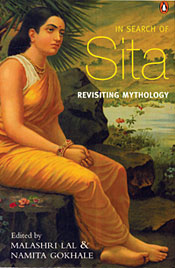 Search of Sita: Revisiting mythology edited by Malashri Lal & Namita Gokhale Yatra/Penguin Books, 2009 |
It was Lord Ram's victory over Ravan, the redemption of his honour at restoring the dignity of his clan, that we will be celebrating this Dasain. Nepalis will worship his prowess at warfare and good Dharma. We will also remember Goddess Durga, whose spirit was evoked to grant the victory of good over evil. Sita stands beside Ram in posters, statues and carvings. But our neglect of Sita is ironic when we analyse the psyche of most women in modern-day South Asia and how predominant her experiences are.
Sita is absent in our prayers, and has been misrepresented as well as misunderstood by readers of Ramayana. Her assertive qualities have been downplayed in several instances where she makes an appearance in the Ramayana. Her taking the agni pariksha for instance, has been viewed by most as a meek submission to her husband's demands. Few see it as an act of defiance and rage at Ram doubting her in front of millions.
Hence, the question: Has the name 'Sita' become synonymous with 'docile' and dutiful'? Or has her name retained anything of her assertiveness like when she stubbornly followed Ram to his exile? The essays and interviews in the book 'In Search of Sita: Revisiting Mythology' by Malashri Lal and Namita Gokhale explore these and other questions with regard to this mythological character, also engaging in dialogues of feminism today, the relation between social movements and women's status, and the interpretation of Sita in texts across South Asia.
SS
READ ALSO:
KITE RUNNERS
For quiet lunches


